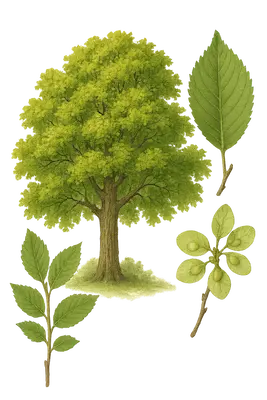Elm (Tree)
Description
Elm trees (Ulmus species) are deciduous trees known for their vase-shaped canopy and serrated leaves with asymmetrical bases. With approximately 35 species, elms are native to temperate regions across North America, Europe, and Asia. They are commonly found in forests, along streets, and in parks.

Allergy Symptoms
Elm pollen can trigger various allergic reactions, including:
- Nasal symptoms: Sneezing, runny or congested nose.
- Ocular symptoms: Itchy, watery, and red eyes.
- Respiratory issues: Coughing, wheezing, and exacerbation of asthma symptoms.
Some individuals may experience Oral Allergy Syndrome (OAS), leading to an itchy or tingling sensation in the mouth when consuming certain foods due to cross-reactivity.
Typical Pollination Period
The pollination period for elm trees varies by species and location:
- Spring-blooming elms: Many elm species release pollen from late winter to early spring, typically between February and April, peaking in March.
- Fall-blooming elms: Certain species, such as the Chinese elm (Ulmus parvifolia), pollinate in late summer to early fall, extending the allergy season into November.
Geographic Distribution
Elm trees are widely distributed across the Northern Hemisphere:
- North America: Species like the American elm (Ulmus americana) are prevalent throughout the United States and Canada.
- Europe: The English elm (Ulmus procera) and other species are common across the continent.
- Asia: Various elm species are found in temperate regions, including parts of China and Southeast Asia.
Tips for Reducing Exposure and Managing Allergies
- Monitor pollen forecasts: Stay informed about local pollen levels, especially during peak elm pollination periods.
- Limit outdoor activities: Reduce time spent outdoors on high pollen count days, particularly during early morning hours when pollen levels are highest.
- Protect indoor environments: Keep windows and doors closed; use air purifiers to minimize indoor pollen exposure.
- Personal hygiene: Shower and change clothes after being outdoors to remove pollen from your body and clothing.
- Medication: Use antihistamines, nasal corticosteroids, or other allergy medications as recommended by a healthcare professional.
- Consult an allergist: For persistent or severe symptoms, seek advice from an allergist who may recommend immunotherapy or other treatments.